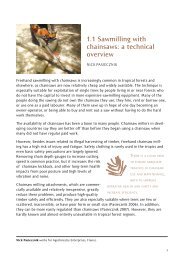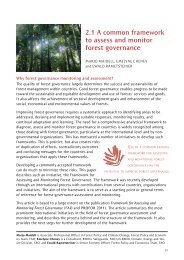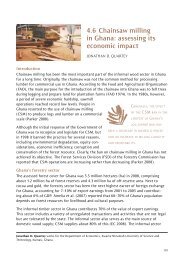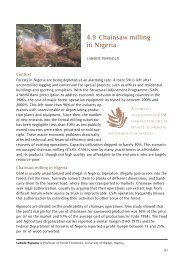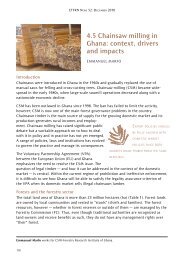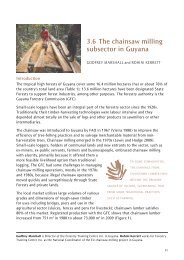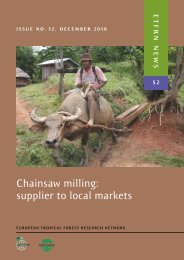Chainsaw milling: supplier to local markets - European Tropical ...
Chainsaw milling: supplier to local markets - European Tropical ...
Chainsaw milling: supplier to local markets - European Tropical ...
You also want an ePaper? Increase the reach of your titles
YUMPU automatically turns print PDFs into web optimized ePapers that Google loves.
3.4 FoREsT commuNiTiEs aND lEgal TimbER iN ThE EcuaDoRiaN amazoN<br />
and other means of production. although it regularly sells shipments of legal timber, this<br />
activity includes only a third of its members. many members still prefer <strong>to</strong> sell their timber<br />
on the informal market. it can be assumed that the main reason for this is the offer of<br />
immediate payment that avoids any bureaucratic or communal control.<br />
The farms of the members of nashE are located along a new road, which is projected <strong>to</strong><br />
lead <strong>to</strong> the rainforest city of Taisha. nashE applies <strong>local</strong> rules on forest management <strong>to</strong><br />
promote legal timber harvesting, but does not own <strong>to</strong>ols or sell timber. The organization<br />
is in the process of refining and enforcing its forest regulations. its members currently<br />
produce illegal timber, but have reached an agreement 5 <strong>to</strong> comply with <strong>local</strong> regulations in<br />
future.<br />
Organizational levels of forest harvesting<br />
in Ecuador, communities’ organizational capacity <strong>to</strong> harvest timber is in its infancy. There<br />
are several initiatives from communities <strong>to</strong> organize themselves but these have not been<br />
consolidated. between 1997 and 2000, about 15 organizations of afro-Ecuadorians and<br />
indigenous Chachi people formed the northern Community Forest network of Esmeraldas<br />
in order <strong>to</strong> negotiate a fair price on wood (padilla 1999). by mid-2007, five organizations<br />
in the southeast and northwest of the country, with the support of nGos, intended <strong>to</strong><br />
create a platform for small producers, but the organization<br />
never became operational.<br />
while mapping the activities of timber-related organizations,<br />
palacios (2008a) noticed that most involved raising<br />
complaints <strong>to</strong> the authorities. it is a challenge <strong>to</strong> form<br />
collaborative organizations that support the improved<br />
harvesting, processing and fair trade of wood.<br />
Capacity for timber production<br />
smallholders possess essentially all native amazonian forest outside of pas. settlers and<br />
indigenous peoples also occupy most of the formally declared national forest reserve<br />
(palacios 2008b).<br />
in most cases, indigenous people share large communal plots of land, which can be up <strong>to</strong><br />
780,000 hectares (palacios 2005). These are often divided in<strong>to</strong> farms, each managed by a<br />
single family. in some cases they carry out unauthorized clear felling; this is more common<br />
when farms are located close <strong>to</strong> roads (romero et al. 2009).<br />
settlers make use of felled wood or sell standing trees <strong>to</strong> intermediaries. in a few cases,<br />
but more often than indigenous families, settlers have their own chainsaws; because they<br />
have processing capacity they have the advantage of selling a more valuable product than<br />
standing trees. mules or people transport the sawn timber from the forest <strong>to</strong> the road.<br />
some indigenous communities in remote places without access <strong>to</strong> roads or navigable rivers<br />
maintain ancestral forms of use and resource management. They fell trees for subsistence<br />
using borrowed chainsaws. This situation changes drastically once a road is built because<br />
81



